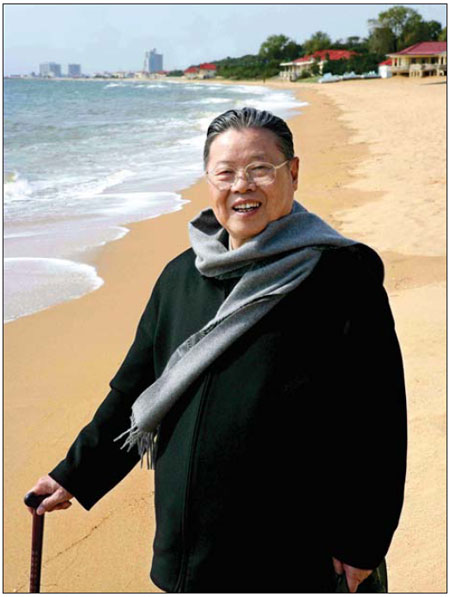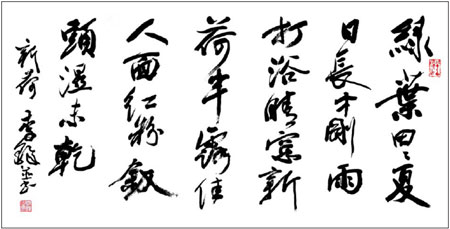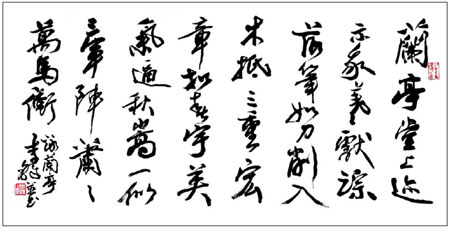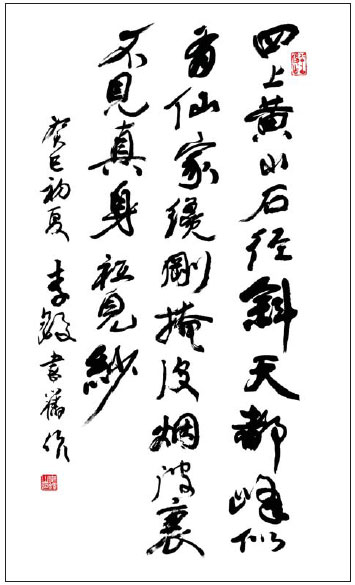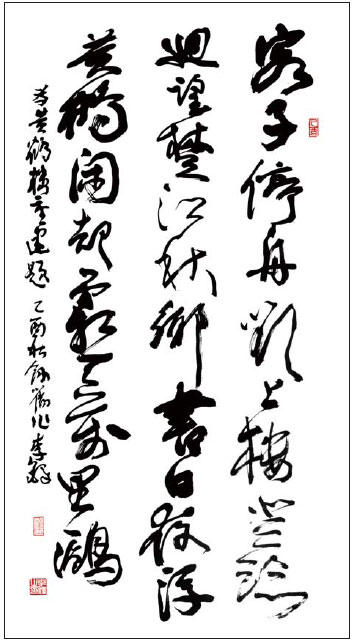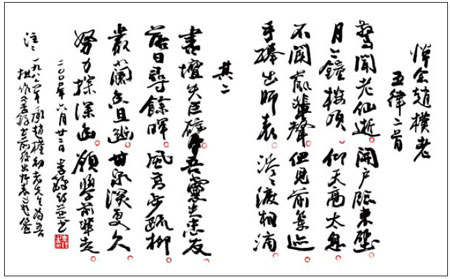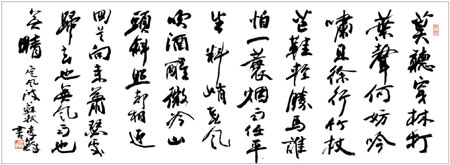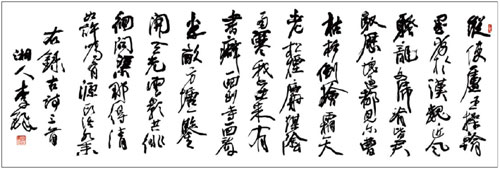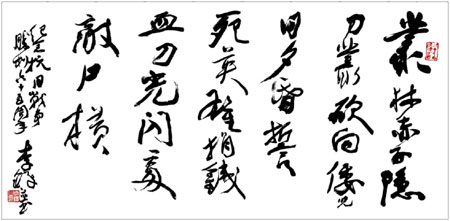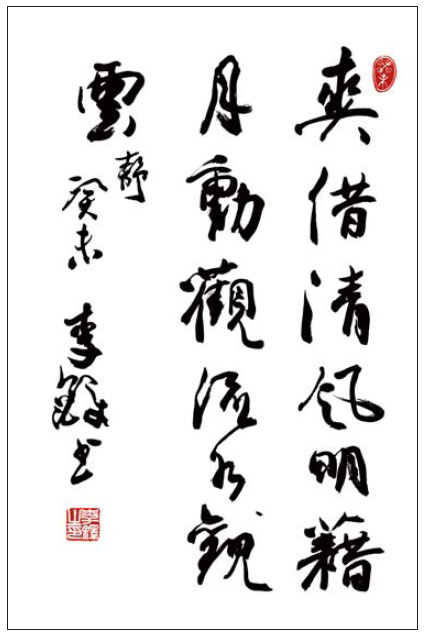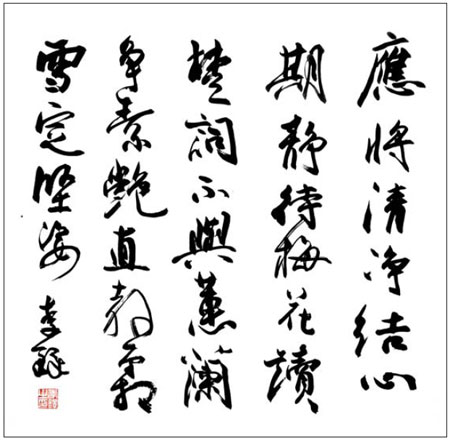Brush with greatness
Updated: 2013-09-08 07:34
By Yang Feiyue (China Daily)
|
|||||||||||
Now 83, renowned calligrapher Li Duo has chronicled life, history and society, Yang Feiyue reports
In the autumn of 2011, famed calligrapher Li Duo held a poetry and calligraphy exhibition at the military museum in Beijing and created quite a sensation in China's art circles.
The exhibition featured more than 140 works of poetry and calligraphy by Li, the fruit of his 70 years in the art business.
It attracted an audience of more than 300,000 and hundreds of leaders and senior officials from the Central Military Commission and the Chinese People's Political Consultative Conference. All spoke highly of his work.
The exhibition also received a letter of congratulations from Liu Yunshan, a member of the Party's top leadership body.
In the letter, Liu said the prosperity and progress of calligraphy depends on both heritage and innovation. Li achieved both and made extraordinary contributions to the art form, he wrote.
Li received a lifetime achievement award at the second Chinese Calligraphy Lanting Pavilion Awards in 2006, the most prestigious honor in Chinese calligraphy. He also won a special award in 2001 for his contributions to calligraphy.
|
Renowned calligrapher Li Duo |
"I have long heard of Li's talent in poetry, but I was still deeply impressed by his exquisite exhibition," said Sun Jiazheng, chairman of the China Federation of Literary and Art Circles.
The strokes of Li's calligraphy perfectly blend with the content of his poetry, which reflects well on his vast learning and perfectly defines a cultural atmosphere, said Sun.
When the 81-year-old calligrapher showed up at the exhibition, introducing the background and details of his creations in his booming voice, everyone was absorbed, Sun recalls.
Li also has profound attainment in classic poetry. His verses are brisk, like a breath of fresh air, with every single word a reflection of the light of his wisdom, said Sun.
His works are filled with love and compliments to China's magnificent landscapes, as well as to the social community and life, Sun added.
"His poetry is filled with revolutionary heroism and romantic color, and reading them broadens my outlook," said Sun.
"We have to look at Li's poetry when studying his calligraphy, which will give us a clear view of the trajectory of his artistic development," said Sun.
His 377-word Long Live the Motherland depicts a senior Party member's patriotism and dedication to his country, said Sun.
Since 2011, Li has been very responsive to the Chinese government's campaign to get in touch with grassroots people, and improve work ethics and writing. He went to classrooms, rural areas and military bases to talk with students, farmers and soldiers and to share his work and enrich their cultural activities.
A collection of his poetry Qinghuaiyincao that came out in the summer attracted wide attention from other poets and calligraphers.
The compendium published 263 of more than his 500 works created from 1973 to 2012 and covers his military life.
His poetry gives full expression to his love of China, his interest in the country's grand landscapes and his refined cultural temperament.
Born in 1930, Li enlisted the army in 1949. He now works as a consultant at the Chinese Calligraphers Association and a professor at the Military Museum of the Chinese People's Revolution.
"Li's poetry collection has set an example for calligraphy art circles in the future and will be a perfect teaching material for the younger generations," said Kong Lingyi, curator of the military museum.
The collection fully showcases the charm of classic Chinese poetry, according to Zhang Daocheng, president of the Beijing Century Celebrity International Painting and Calligraphy Institute.
Works composed after Li turned 70 comprise a majority of the collection, including more than 40 works from 2004 when the poet expressed his ambition for greater achievements in his late years.
"Li's poetry is a true reflection of his character. He has paid special attention to the healthy growth of young people, and often does charity work for society, especially for people at the grassroots level," said Zhang, who also expressed his gratitude for Li's painstaking efforts in the development of the institute.
Li loves traditional culture and has an acute artistic perception, and his approach to creativity is full of life and very popular with the public, said Zhang Kunshan, member of the Chinese Calligraphers Association.
Some of his works recount major historical events such as the return of Hong Kong and the Launch of the Shenzhou spacecraft. Some were created as he traveled around the country, such as at the Longmen Grottoes and the Lijiang River.
Li also created many works on landscapes, bird-and-flower paintings and figure paintings using concise language in harmony with the scenes, said Zhang.
In 1995, Li finished his rendering of Sun Tze's The Art of War. Stretching more than 220 meters, the manuscript went on display at the military museum the same year, receiving very good reviews from the State leaders of the time including Jiang Zemin.
Innovation
In recent years, Li has focused on innovations in the art of calligraphy, working on the development of theories in the art and education.
Studying various works by famous calligraphers in China's history since he was in his youth, Li maintained a critical eye for magnum opuses and gradually developed his own style.
His works are widely regarded as unassuming and aesthetic, delicate yet in touch with life, and are very popular in China and abroad.
Some have made their way to the United Nations, other places in the United States and Europe.
On the home front, many of his works can be found in newspapers and magazines, and many are enshrined in noted museums or inscribed at tourist attractions for visitors to enjoy and appreciate.
Li has also been invited to Japan and Southeast Asian countries on many occasions for exhibitions and lectures on calligraphy.
Contact the writer at yangfeiyue@chinadaily.com.cn
|
Li's poetry about summer. |
|
LI's poem on Lanting Xu, Essay on the Orchid Pavilion. Lanting Xu was the best-known example of early xingshu style. |
|
Li is a noted poet as well as a talented calligrapher. |
|
Climbing Guanque Tower is another of his poems. |
|
Two of his own poems. |
|
Li's rendering of Dingfengbo, a famous Song Dynasty (960-1279) work by Su Shi. |
|
Li's interpretation of three ancient poems. |
|
Commemorating the 60th anniversary of the War of Resistance against Japanese Aggression. |
|
Describing scenery in the evening. |
|
Work calling for inner peace. |
|
Work by Li on a paper fan in xingshu style. Characters in the style are not abbreviated or connected, but strokes within the characters often run together. Because it is not as abbreviated as cursive, most Chinese people can read it. |
(China Daily 09/08/2013 page4)
Today's Top News
Assad agrees to hand over chemical weapons
Rail route to Europe improves freight transport
3 sentenced to death for Xinjiang terror attack
China sets caps for rare earths exploration
Xi welcomes Iran nuclear talks
Moves against China firms criticized
China gets tough on air pollution
Trending news across China
Hot Topics
Lunar probe , China growth forecasts, Emission rules get tougher, China seen through 'colored lens', International board,
Editor's Picks

|

|

|

|

|

|
